Welcome to Matrix Education
To ensure we are showing you the most relevant content, please select your location below.
Select a year to see courses
Learn online or on-campus during the term or school holidays
Learn online or on-campus during the term or school holidays
Learn online or on-campus during the term or school holidays
Learn online or on-campus during the term or school holidays
Learn online or on-campus during the term or school holidays
Learn online or on-campus during the term or school holidays
Learn online or on-campus during the term or school holidays
Get HSC Trial exam ready in just a week
Get HSC exam ready in just a week
Select a year to see available courses
Science guides to help you get ahead
Science guides to help you get ahead
The discursive essay is a new component of Module C: The Craft of Writing. In this article, we explain what a discursive essay is and give you a step-by-step process for writing one.

Join 75,893 students who already have a head start.
"*" indicates required fields
You might also like
Related courses

Join 8000+ students each term who already have a head start on their school academic journey.
Do you know what a discursive essay is? Do you know what makes it different from a persuasive essay? What does “discursive” even mean? If these questions have ever crossed, you’re not alone. But don’t worry! In this post, we’ll explain what a discursive essay is and how to write one worthy of a Band 6.
A discursive essay is a type of writing that explores multiple perspectives on a topic.
NESA defines discursive texts as:
Texts whose primary focus is to explore an idea or variety of topics. These texts involve the discussion of an idea(s) or opinion(s) without the direct intention of persuading the reader, listener or viewer to adopt any single point of view. Discursive texts can be humorous or serious in tone and can have a formal or informal register.
NESA adds that discursive essays can also include the following features:
When you write discursive essays, you will need to discuss ideas in this way.
But, don’t worry—it’s a lot more fun than it sounds. Let’s see why.
Write the perfect discursive response with these techniques, examples, and planning tips Fill out your details below to get this resource emailed to you. "*" indicates required fields
Get your free discursive essay cheatsheet!

Get your free discursive essay cheatsheet!
The 2019 HSC English Syllabus made significant changes to Module C.
Instead of just analysing texts, the new Module C: The Craft of Writing focuses on improving your writing skills.
To do this, the Module requires you to write in a variety of different modes:
NESA aims to make you a more confident and competent communicator, broadening your writing skills so they’re practical even beyond high school and the HSC.
There are stylistic and structural differences between a discursive and a persuasive essay.
Most essays that you write in high school ask you to take a position on something and argue for it. Essentially, you’re being asked to persuade a reader of something; a theme, idea, or an idea’s connection to context.
In contrast, discursive essays don’t require you to take a particular position on something.
When you write a discursive essay, you can explore your topic from a few different perspectives. This gives you the opportunity to highlight the pros and cons, and see what others might think about the topic.
Discursive essays are also less rigid and formal than the standard persuasive essay you’re asked to write in other Modules. In a discursive essay, you can develop your own voice and style.
The following table shows the differences in forms:
| Table: Comparison of Discursive and Persuasive Essays | ||
| Detail | Discursive Essay | Persuasive Essay |
| Register of language | A mix of formal and informal languages with occasional colloquialisms | Formal |
| Style and tone | Aim for an educated audience, but the tone and style can be friendly and more openly subjective | Academic, objective, and intellectual |
| Use of first-person pronouns | First-person pronouns are fine | First-person pronouns should be used cautiously and judiciously |
| Use of figurative devices | Should be used throughout | Not recommended |
| Use of evidence and examples | Yes, but not in a T.E.E.L or P.E.E.L format | Yes, consistently and in a particular format |
| Structure | Requires an introduction, conclusion, and paragraphing. Paragraph length can vary. There is no strict format. | Introduction, body paragraphs, conclusion. Formal structure appropriate to the Module. Consistent paragraph length throughout. |
Learn how to research, structure, and write a discursive essay with expert step-by-step guidance and feedback!
Get writing help and feedback from the English experts
9 weeks of lessons, quizzes, and 1-to-1 support. 20,000+ students have improved their marks with Matrix. Book a free trial today.
When you’re writing an essay, your opinion always counts. Whether you’re writing a detailed persuasive essay for Module B or a discursive piece for a Module C assessment, your ideas and opinions are crucial.
The difference is how you present them. When you write a persuasive essay, there is the assumption that it is your voice and your opinion. So, teachers often say not to use personal pronouns because adding a stronger element of your personal voice will make your writing seem too subjective and, therefore, not as persuasive.
Personal pronouns in persuasive essays are also often seen as being tautological (saying something twice, which some see as a stylistic fault).
In contrast, in a discursive essay, you can take a more personal approach. For example, including personal anecdotes and your own strong voice can help add depth and insight to the perspectives you discuss.
Discursive essays are stylistically flexible compared to persuasive essays. They can be serious or they can be humorous.
They’re not a new style of writing – discursive essays were a very common form of writing during the Renaissance and Early Modern Period.
Mary Wollstonecraft, Charles Lamb, Elizabeth Barret Browning, Samuel Johnson, GK Chesterton, and Michel de Montaigne were all famous essayists in their time who wrote discursive texts as well as persuasive ones.
Over time, the discursive essay became less common than the persuasive essay. In our context, discursive writing is becoming more common again. Contemporary writers such as Zadie Smith, Helen Garner, John D’Agata, and Ta-Nesi Coates all have discursive essays among their work.
You’ll find examples of discursive writing in publications like:
You’ll need to provide evidence in your discursive essays, but not in the same sense as your persuasive writing.
The idea is to explore ideas or a variety of topics and to do this, you’ll have to present some evidence. But this won’t necessarily include literary analysis (although it might if you so choose).
You’re not writing T.E.E.L or P.E.E.L paragraphs or listing techniques and effects (not that you should ever simply list techniques and effects!).
Instead, you’ll be writing about ideas and maybe supporting these with quotations from other people, or anecdotes and reflections from your personal experience.
In persuasive essays, you’ll use strict essay structures depending on whether you’re discussing one or more texts and the Module you’re studying. Your paragraphs should be consistent in length and have explicit signposting, such as topic sentences and linking sentences.
Discursive essays don’t have the same rigid structure or approach to signposting.
In a discursive essay, you may not be discussing texts, but rather ideas or things – for instance, an advertisement, political system, or a type of sneaker. This means that some paragraphs will need to be longer than others, depending on the idea you’re discussing.
In addition, because a discursive essay will want you to discuss things from an objective point of view, but also include your anecdotal experiences, you may find that your anecdotes are shorter than your discussion of ideas.
While you will need to introduce your ideas in the introduction and at the start of each paragraph, you won’t need to have formal thesis statements and topic sentences. After all, you’re trying to be more conversational and less formal.
Like any essay, you can follow a process to produce high-quality essays and make your life easier.
Let’s take a look at the steps Matrix students use.

Now we’ll explore in-depth how to write a discursive essay. This process has the following steps:
When you write a persuasive essay, you are given a specific question. With a discursive essay, you may not have a question at all. Instead, your discursive tasks might come in different forms:
Because of the nature of discursive essays, you won’t be analysing and unpacking a question like you would for a persuasive essay. Instead, you’ll need to research and explore different ideas or subjects.
As with any essay, you must take the time to research and plan your work first. This is especially true if you are writing on a topic for the first time.
Before you start anything, you need to consider what you know about the topic.
Your first step is to create a mind map that lists what you know about the topic. Mind maps should list the aspects of the topic that you think are worth exploring.

Now that you’ve brainstormed ideas, it’s time to develop your ideas through research.
Fortunately, you have the power of the internet at your fingers. With your mind map as a guide, start researching the topics you’ve listed.
YouTube is a good place to start looking for basic information about subjects.
Make sure you try to use reputable sites. For example, a personal blog is not going to have the same level of trustworthiness as major news or academic websites.
Start by looking at the broad topic you find interesting, and then pick two or three aspects to consider in detail.
Don’t let your research get too out of hand. Keep your focus narrow enough to manage the word count (1000-1200 words), but wide enough to explore different viewpoints.
Some dos and don’ts:
Once you’ve researched your topic, you’re ready to start planning your essay.
Even though a discursive essay lacks the formality of a persuasive response, you still need a logical structure.
This means you’ll need:
Planning is important because it will help you structure your introduction and develop your ideas. Your introduction should briefly introduce the topic and why you’re going to talk about it.
When you plan, note down your ideas and think about how to best present them so the reader can easily follow. This means planning what you will discuss in each paragraph and what bits of evidence are going to best assist this.
Here’s a possible 4-part structure for the body of your essay:

Remember, this scaffold isn’t rigid. You could quite easily switch around where you put your anecdote. Or, rather than exploring different perspectives in different paragraphs, you may want to contrast these views in the same paragraph. In a discursive essay, you have flexibility.
Now you’ve planned everything, you’re set to start writing.
Don’t feel ready to write yet? Do you need to see an exemplary discursive essay to see what you should be doing?
The introduction of a discursive response is different to other essays in that you don’t have a formal thesis statement and thematic framework.
Instead, you can ask questions to introduce the topic or use an anecdote to frame the topic. You also don’t need to lay out a roadmap of how your essay will unfold, so you can spend time explaining your interest in the topic.
Some effective ways to start discursive essays are:
The length of your introduction can vary. As you’re not trying to explain the structure of your argument, you can focus on introducing the topic in the manner you find most engaging.
Boost your HSC English Advanced marks!
Expert teachers, detailed feedback, and 1-to-1 support to help you excel. Book your free trial today.
This is where your planning comes in handy. When you’re writing the body of your discursive response, you want to think about the order of information your reader needs to make sense of your discussion. So, use your planning notes to structure your body paragraphs.
While you don’t need a topic sentence per se, you need to get to the subject of the paragraph within the first couple of sentences. You can vary the length of your paragraphs to suit the amount of material you want to discuss.
Some useful rules for writing your paragraphs:
Your conclusion should summarise and tie things together.
You don’t need to follow the rigid formula of :
Instead, you need to tie together the various perspectives that you’ve looked at in your essay.
Remember, the point of a discursive essay is to explore a subject from different perspectives (and not persuade a single perspective).
Because of this, you want to take your reader back through the different perspectives you’ve encountered. Perhaps you might present the perspective on a matter you hold – for example, “Yes, I do prefer dark chocolate to white chocolate, but that doesn’t mean that white chocolate is not without its uses, benefits, or zealots.”
Once you’ve finished your conclusion…
Congratulations!
You’ve finished your first draft. Now you’re ready to proofread and edit it to produce a second draft.
Once you’ve completed your first draft, put it aside for a couple of hours or a day before you reread and edit it. This way, you can look at it with “fresh eyes”, allowing you to be a bit more objective when proofing your first draft.
Ideally, you want to print out your first draft, so you can annotate it as you go. But that is not always convenient and it’s certainly not environmentally friendly. Using track changes on a Word, Pages, or Google Doc will also work.
No matter your method, you’ll want to keep track of your changes and, perhaps, demonstrate to your teachers that you’ve employed an editing process.
To proofread and edit your response:
Be objective about your writing.
Often, it’s hard to separate ourselves and our feelings from the things that we produce.
This can make it difficult to give an honest judgement of what works and what doesn’t. Do your best to be as objective and critical about your work as you can.
Once you’ve finished proofing and editing your work you’re ready to use these notes and edits to write your second draft.
You should write a second draft from the beginning rather than editing an existing document.
Rewriting sounds like a lot of work, doesn’t it? But it’ll be worth it.
Why?
Rewriting drafts from scratch will always improve the quality of the writing. Because you’re not simply working with sentences already on a page but, rather, rewriting them, you will be more inclined to change them and make them better.
What do I mean?
Do you ever look at a sentence in a Word document that you’re editing and say to yourself, “I know I should change that sentence, but I really like it so I’m going to make it work?”
A lot of people do, but it’s a bad habit to get into.
Rewriting your second draft from a blank page will make you less inclined to hang onto sentences that may seem nice to you, but aren’t great at conveying your ideas. In addition, rewriting your essay will make it easier to include new rhetorical devices and literary techniques, rearrange things, and make large structural changes.
Don’t hesitate to use the drafting process as a way to experiment with your writing and make it better.
What do I do once I’ve got a second draft of my discursive essay?
If you must, you can submit your second draft. Ideally, though, you should try and get a second opinion.
How should you do this?
Maybe you can run it by a friend or family member. Matrix students get feedback from their teachers and workshop tutors to help them develop their drafts. If you approach your schoolteacher politely, they might give you some feedback if the task allows for it.
The drafting process doesn’t have to finish with the 3rd or, even, the fourth draft. You should keep refining your work to make sure it is as good as it can possibly be. Band 6 results don’t just miraculously appear, they are developed over time.
Once you have a draft you’re happy with, you’re to SUBMIT!
From the comfort of your own home, access our expert-led video lessons, detailed Theory Books, and countless practice questions to help you succeed in your HSC. Start your free trial today!
Boost your HSC English marks from home
Expert teachers, detailed feedback, one-to-one help! Learn from home with Matrix+ OnlineEnglish courses.
Written by Matrix English Team
The Matrix English Team are tutors and teachers with a passion for English and a dedication to seeing Matrix Students achieving their academic goals.© Matrix Education and www.matrix.edu.au, 2025. Unauthorised use and/or duplication of this material without express and written permission from this site’s author and/or owner is strictly prohibited. Excerpts and links may be used, provided that full and clear credit is given to Matrix Education and www.matrix.edu.au with appropriate and specific direction to the original content.